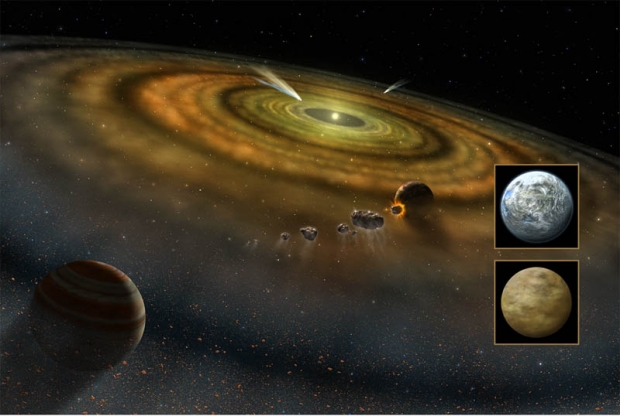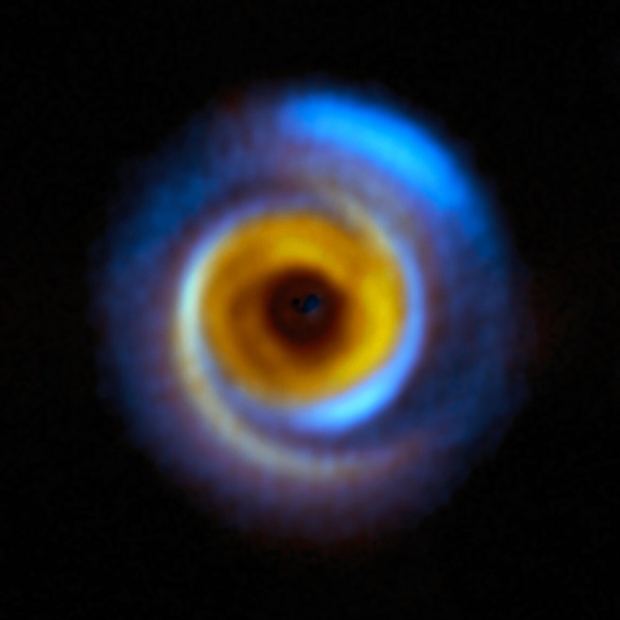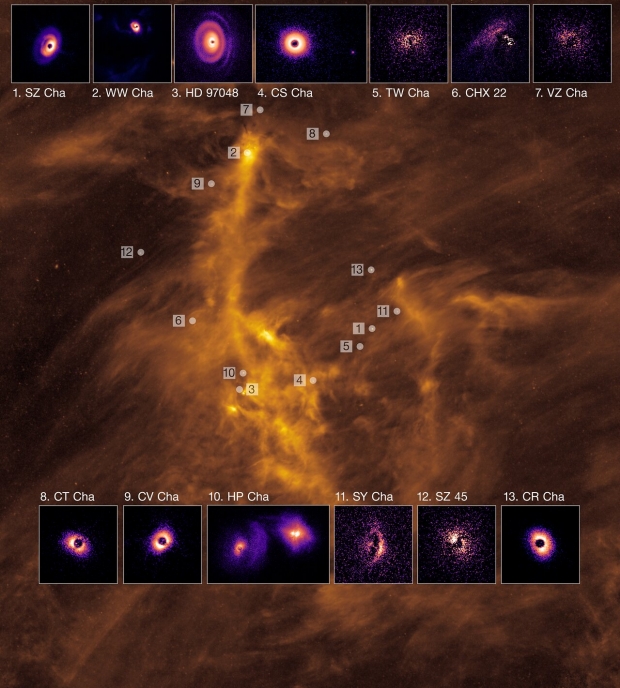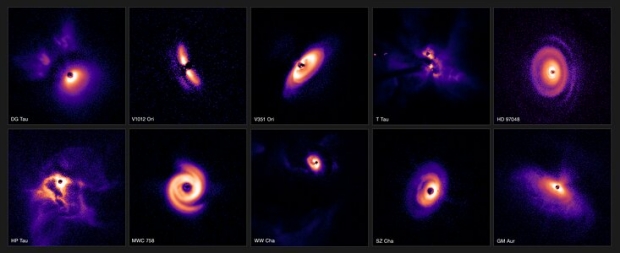Planet formation is a fascinating subtopic of the exoplanet hunt, and it may just have produced the first exoplanet detection in data that go back as far back as 1981, though the event in question has never been confirmed as being caused by a planet. I learned this through a paper sent me recently by Jean Schneider (Observatoire de Paris), who along with colleague Danielle Briot wrote about the early days of transit searches in a chapter for the Handbook of Exoplanets (Springer, 2018).
I want to dig deeper into that chapter in a later post, but for now, I note that the planet Beta Pictoris b, discovered in 2008 and orbiting an infant star 63 light years from Earth, may have transited in 1981, according to subsequent papers on the matter. The debris disk around the primary has long fascinated astronomers and it has been investigated for the possible presence of comet-like bodies and subjected to direct imaging searches, which revealed Beta Pictoris b and confirmed it in 2009. But the 1981 data show light variations that could be interpreted as a transit.

Image: Various planet formation processes, including exocomets and other planetesimals, around Beta Pictoris, a very young type A V star. Credit: NASA/FUSE/Lynette Cook.
Testing the matter involved a nano-satellite called PicSat designed by astronomers at the Paris-Meudon observatory to look for a possible 2018 transit. Unfortunately, the mission failed when communications were lost. As Schneider and Briot write:
If the transit is confirmed in the near future, we could obtain better observations of the following transit in 2053, when the period will be known more accurately and when we could use very large and extraordinary outstanding future instruments. So, will Beta Pictoris b win the title of the first detected exoplanet?
The massive debris disk at Beta Pictoris is asymmetric (likely the result of perturbations by another star), and seen edge-on from Earth. But the beauty of the circumstellar disks out of which planets form is that if we peer into planet-forming regions, we can find them oriented in all kinds of ways, as we learn in a new series of images from the European Southern Observatory’s Very Large Telescope. They’re part of a survey of how planetary systems form, and they mark a transition between the intense study of individual star systems to a broad swath of planets and stars. As Christian Ginski (University of Galway, Ireland) puts it, “We’ve gone from the intense study of individual star systems to this huge overview of entire star-forming regions.”
Let’s home in on a single system to begin with to ponder how much we can learn from these disks.

Image: This composite image shows the MWC 758 planet-forming disc, located about 500 light-years away in the Taurus region, as seen with two different facilities. The yellow colour represents infrared observations obtained with the Spectro-Polarimetric High-contrast Exoplanet REsearch (SPHERE) instrument on ESO’s Very Large Telescope (VLT). The blue regions on the other hand correspond to observations performed with the Atacama Large Millimeter/submillimeter Array (ALMA), in which ESO is a partner. These facilities allow astronomers to map how dust is distributed around this and other stars in different but complementary ways. SPHERE captures light from the host star that has been scattered by the dust around it, whereas ALMA registers radiation directly emitted by the dust itself. These observations combined help astronomers understand how planets may form in the dusty discs surrounding young stars. Credit: ESO/A. Garufi et al.; R. Dong et al.; ALMA (ESO/NAOJ/NRAO).
The new ESO imagery takes in numerous young stars like this one. What leaps out here is the wide range of formation scenarios. Working with the star-forming regions at Orion, Taurus and Chamaeleon I, an international team of astronomers investigated 86 stars using SPHERE, the Spectro-Polarimetric High-contrast Exoplanet REsearch instrument mounted on the VLT. The quality of the imagery is attributable to SPHERE’s adaptive optics, which allows disks to be imaged around stars down to about half the Sun’s mass while correcting for the distortions produced by looking through the Earth’s atmosphere. The use of ALMA, the Atacama Large Millimeter/submillimeter Array, helped quantify the amount of dust in these systems.
Image: This research brings together observations of more than 80 young stars that might have planets forming around them in spectacular discs. This small selection from the survey shows 10 discs from the three regions of our galaxy observed in the papers. V351 Ori and V1012 Ori are located in the most distant of the three regions, the gas-rich cloud of Orion, some 1600 light-years from Earth. DG Tau, T Tau, HP Tau, MWC758 and GM Aur are located in the Taurus region, while HD 97048, WW Cha and SZ Cha can be found in Chamaeleon I, all of which are about 600 light-years from Earth. The discs have been scaled to appear roughly the same size in this composition. Credit: ESO/C. Ginski, A. Garufi, P.-G. Valegård et al.
The imagery is stunning. Per-Gunnar Valegård (University of Amsterdam), who led the work on Orion, noted “It is almost poetic that the processes that mark the start of the journey towards forming planets and ultimately life in our own Solar System should be so beautiful.” I think we can drop that word ‘almost’ as we are reminded that the sheer wonder of celestial vistas at ever increasing scales is what drew many of us into astronomy at an early age. We’re a long way from those grainy Palomar images of Jupiter and Saturn that I acquired decades ago at Adler Planetarium in Chicago.

Image: Planet-forming discs around young stars and their location within the gas-rich cloud of Chamaeleon I, roughly 600 light-years from Earth. The team observed 20 stars in the Chamaeleon I region, detecting discs around 13. The background image shows an infrared view of Chamaeleon I captured by the Herschel Space Observatory. Credit: ESO/C. Ginski et al.; ESA/Herschel.
Meanwhile, in a separate investigation of the young star T Chamaeleontis, we gain insights into planet formation in its latter stages. Here we have the James Webb Space Telescope to thank. Naman Bajaj (University of Arizona) and Uma Gorti (SETI Institute) have been able to extract data on the four lines of the noble gases neon (Ne) and argon (Ar), with the neon detection showing processes that are occurring over an extended area. The observations show dispersing gasses from a planet-forming disk that is in its latter stages, completing the formation process. These ‘winds’ seem to be driven by stellar photons or, according to Bajaj, by the magnetic field within the disk itself.
The find is significant, says Richard Alexander (University of Leicester):
“We first used neon to study planet-forming discs more than a decade ago, testing our computational simulations against data from Spitzer, and new observations we obtained with the ESO VLT. We learned a lot, but those observations didn’t allow us to measure how much mass the discs were losing. The new JWST data are spectacular, and being able to resolve disc winds in images is something I never thought would be possible. With more observations like this still to come, JWST will enable us to understand young planetary systems as never before.”
The paper on the history of transit studies is Briot & Schneider, “Prehistory of Transit Searches,” in Handbook of Exoplanets, 2nd edition.
The papers on the SPHERE work are Ginski et al., “The SPHERE view of the Chamaeleon I star-forming region: The full census of planet-forming disks with GTO and DESTINYS programs”, Astronomy & Astrophysics (abstract).
And two other papers in the same issue: Garufi et al., “The SPHERE view of the Taurus star-forming region: The full census of planet-forming disks with GTO and DESTINYS programs,” (abstract) and Valegard et al., “Disk Evolution Study Through Imaging of Nearby Young Stars (DESTINYS): The SPHERE view of the Orion star-forming region” (abstract).
The paper on T Chamaeleontis is Bajaj et al., “JWST MIRI MRS Observations of T Cha: Discovery of a Spatially Resolved Disk Wind,” The Astronomical Journal Vol. 167, No. 3 (4 March 2024), 127 (abstract).




The earlier Centauri Dreams entry “Musing on Red Dwarf Planets” pretty much set the stage for the current topic. One discussion point was what could distinguish planet formation over the range of main sequence protostar masses, luminosities, snow lines … and especially timelines. There were many timelines to consider: the collapse proto star to main sequence ignition, the distinct circumstellar disk and the coalescence into planets. From the standpoint of searching for habitable exoplanets, it was a question of whether the parameters would be more favorable for one stellar spectral type over another. For example, a red dwarf formation ( vs. a solar protostar analog) promised a longer stable main sequence life, but also a greater risk of UV eruptions and magnetic storms. Unless the sequence of events at the red dwarf’s formation worked to some advantage not modeled thus far…
So this article did catch my eye along with another one in the AAAS journal Science, “A far ultraviolet-driven photoevaporation flow observed in a protoplanetary disk.” ( 01 March 2024, pp 988 -991 – Olivier Berne et al., a considerable number of investigators). In this case, the Orion Bar region of the Orion Nebula was the selected area of study. The “photoevaporation flow” is ( or was?) driven high mass stars in the surrounding stellar nursery region.
In each of these papers, the images provided by observatories are remarkable, wondrous images of planetary systems yet to come. I would say startling to witness, but elusive to understand or compare. In terms of whether there is advantage in having a terrestrial planet form at a red or yellow protostar, I can’t yet extract any argument pro or con. But in the case of the AAAS paper, it would appear that a significant external factor for the Red Dwarf Musing debate would be the number of proximity of very massive stars in the star forming region.
And then, since red dwarf stars are a population majority, their particular proximity to the EUV source radiation would effect the rate of photoevaporation of the disk.
Judging by this, circumstellar disk dispersal would be do in part to the protostar radiation flux, but also to that of the rapidly formed B and O stars in the vicinity and how close by an M might be to several such sources.
Complicated, no doubt, but I would rather have more chance in the process of Red Dwarf planet formation than to write off all hope of habitable exoplanets in such thereabouts.
An outstanding review of outstanding images and detections. By the way Chicago’s planetarium is the Adler (I cataloged its rare book collection while I was in college!). The Hayden is in NYC…
Good grief, you’re right, of course. I’ll change that right away. Thanks for catching my gaffe!
See this article on even earlier exoplanet detections:
https://exoplanets.nasa.gov/news/1467/overlooked-treasure-the-first-
evidence-of-exoplanets/
Would like to apologize for some grammatical mistakes in the earlier post (e.g. “do” for “due”, etc.). But regarding this overall topic regarding circumstellar disks and developmental differences for planets formed around red or yellow suns: If the dispersal of the gas cloud surrounding protoplanets depends on the presence of massive hot stars, then there is also another consideration beside their early or main sequence behavior. The vicinity hot stars will not be around or on the main sequence for very long. If we are talking about O or B stars, they might go supernova before the planet formation process is all done. No? And whether we are talking about red dwarfs or stars like the sun, such events could introduce more noise or variation into a protoplanet’s formation history.
Based on the mass-luminosity lifetime relations, here are 3 different mass stars with presumed lifetimes on the main sequence:
M in solar mass Lifetime millions of years
40 ( B) 1
10 31
5 170
At the very least, red dwarfs, once they are formed will last a long time while O, B and A stars will last not remain around long. Likely they are not formed as frequently as well. But the formation process toward the main sequence is slower by comparison. And to make the story short, the population of EUV propagating stars in the surrounding space could go through their entire MS lifetime before the red dwarfs even get started.
This would be another significant process with a random variation that would make exoplanet characteristics difficult to predict for classes of stars. Numerous red dwarfs could be close to such massive stars or distant, or else caught in the supernova shock at varied periods of protoplanetary disk formation periods.
As would G stars, of course. Natural selection at work, it could be said.